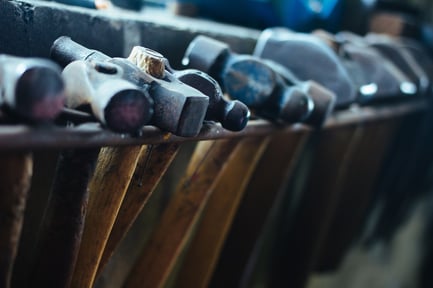The old saying goes, “a carpenter is only as good as his tools”. If that saying is true, the tools of any skilled tradesman would be the most valuable asset they own. Try to picture a carpenter working without a hammer, a plumber without a wrench, or an excavating contractor without a backhoe. Having the appropriate coverage on these tools and equipment is vital. Yet, in many cases, we run into situations where those tools are either covered inappropriately (over/under valued), or not covered at all. Let’s briefly discuss different aspects of this coverage and areas you should review within your own insurance program to ensure your tools and equipment are appropriately covered.

In the insurance world, the tool coverage we are about to discuss is often referred to as Inland Marine coverage or an Equipment Floater. There is also different coverage for equipment within the floater depending on who owns the equipment and who uses the equipment. In most cases, we will see 4 different coverage parts to this equipment floater.
- Scheduled Equipment
Scheduled Equipment is the first aspect of an Inland Marine policy. This is comprised of a list of equipment and tools owned by the contractor. These lists will reference the specific equipment and include a description of the tool, complete with serial/model number, and value of the item. In most cases, the equipment listed in this section will be covered on an Actual Cash Value basis. As a contractor, it is important that you review those figures annually. Without a close eye on this, it is easy to over insure equipment. Equipment values rarely stay the same over the course of many years. Depreciation, and even appreciation, are factors to consider here. When putting together your list of scheduled equipment, you need to weigh the value versus the cost to insure it. Adding equipment with a value less than a thousand dollars or less than your policy’s deductible may not make sense here.
- Miscellaneous Tools
The lower value items that I now have you thinking about, such as power tools or hand tools, will often get caught in the Miscellaneous Tools section of your Inland Marine policy. Here, you would not have to list each hand tool you own. Instead, the insurance company will provide a specific limit to cover these items. As an example, you may see $2,500 per tool and a maximum of $20,000 total limit. This is the “catch-all” for the owned equipment you didn’t put in section 1 (scheduled equipment). As a business owner, it is also important to note that tools owned by your employees are not covered here. Instead, you would need to add specific coverage limits for your employee’s tools separately.
- Leased or Rented Equipment
The third part of an Inland Marine policy that should be given consideration is coverage for Leased or Rented Equipment. Perhaps you are a “jack of all trades” contractor, but don’t own every piece of specialty equipment ever created. You find yourself having to rent certain specialty items once or twice a month from your preferred equipment dealer. Your insurance company should have the capability of adding a Leased and Rented Equipment limit to your policy. As a contractor, you will have to make a determination on the single most valuable unit you may rent over the course of the year and use that as a basis. If you are only renting a scissor lift you may only need a limit of $20,000. If you find yourself renting an excavator or articulated dump truck, you may want to look at limits of $300,000 and beyond. It is important to remember that the Leased and Rented Equipment Coverage is meant for those occasions where you are renting a unit for a shorter period of time, up to one month. For any rental period longer than that we generally advise you to call your agent to add the unit to your equipment schedule. Those situations are common with long term leases or rent-to-own options. In the event that you are renting a piece of equipment with a replacement cost value higher than the limit on your policy, simply let your agent know and your policy limit can be bumped up to accommodate the value for the period of time the equipment is in your possession. If you find you are continually asking your agent to temporarily increase your Leased and Rented limit, you should strongly consider permanently increasing that limit amount on your policy.
- Loaned or Borrowed Equipment
An important note to remember with leased and rented equipment is that a standard Inland Marine policy will exclude coverage for equipment you own that is leased or rented to others. Unless you are in the business of renting equipment, this situation may leave you without coverage. A good rule of thumb is to not charge a fee for letting another contractor use your equipment. This may help you sidestep an uncovered claim assuming your policy also covers Loaned or Borrowed Equipment. This situation comes up quite frequently with the use of scaffolding and lifts. Loaned equipment to others, or borrowed equipment from others, may also be excluded on your current policy. You should contact your agent to make that determination, and add the coverage accordingly. We understand this situation may come up quite frequently, but unless your Inland Marine policy is written correctly, those vital tools and equipment may be vulnerable.
Just as a skilled furniture maker dovetails all of his joints, your equipment floater policy should contain all 4 aspects of coverage mentioned above. The Scheduled Equipment, Miscellaneous Equipment, Leased/Rented and Loaned/Borrowed equipment coverage all dovetail together to create a seamless insurance program for the important tools and equipment your business depends on. Contact your trusted insurance advisor to be sure the construction equipment you depend on is adequately covered in the event of a loss. Don’t let yourself become the excavator without a backhoe!

COMMENTS